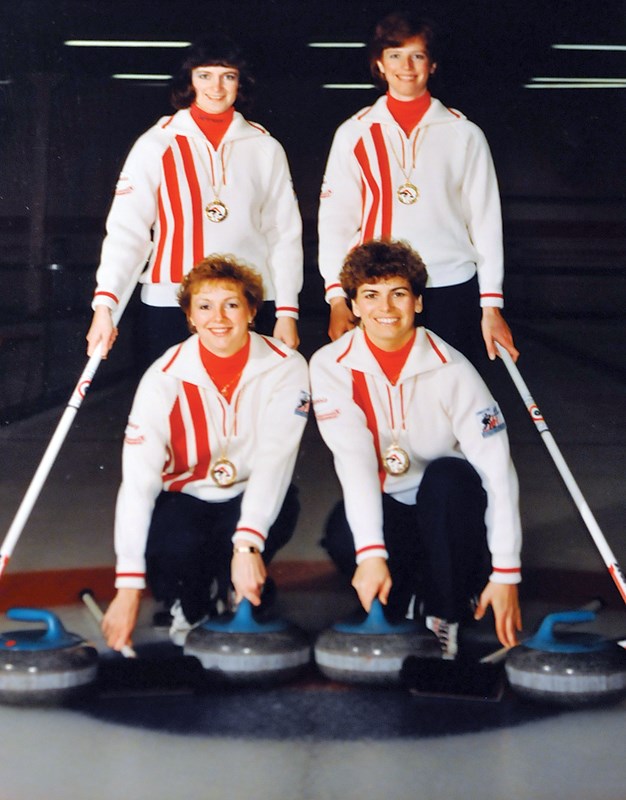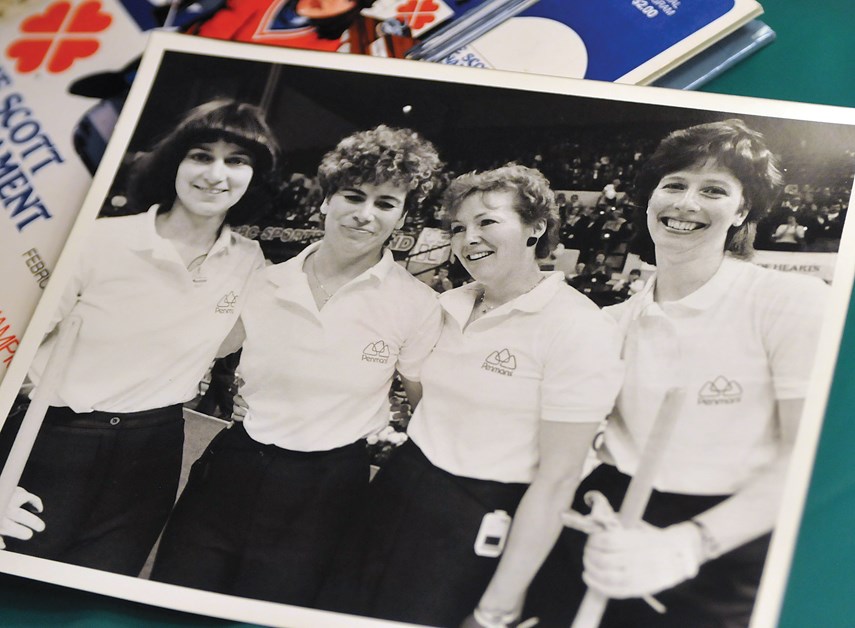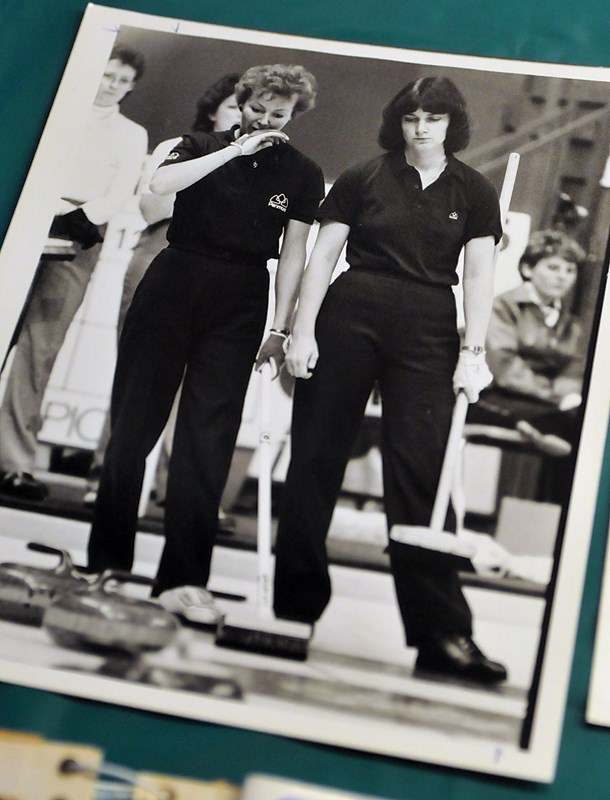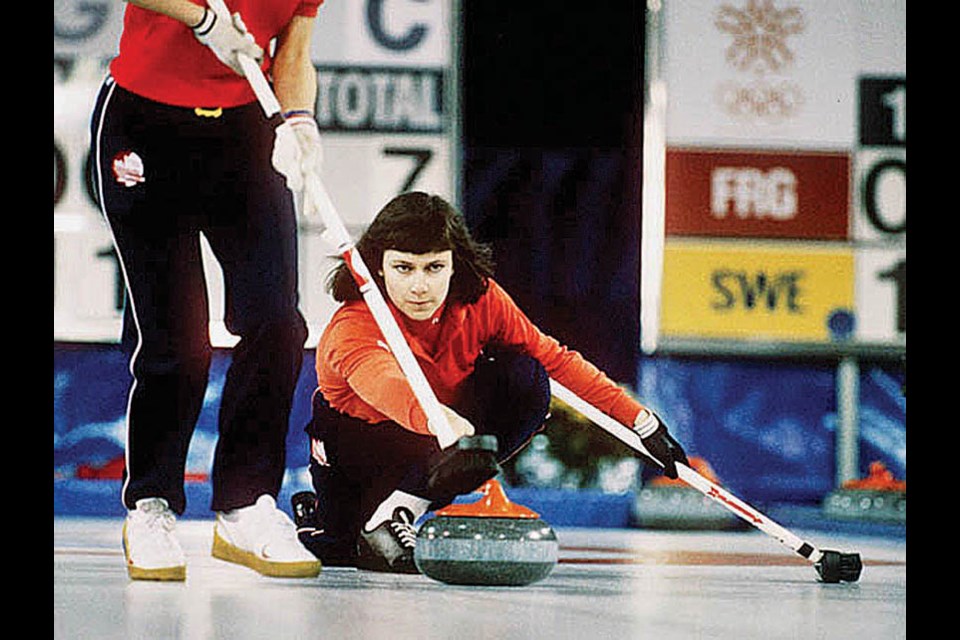The curling team skipped by Linda Moore is headed to the North Shore Sports Hall of Fame, thanks in large part to one of the greatest win streaks the sport has ever seen.
The team of Moore, third Lindsay Sparkes, second Debbie Jones and lead Laurie Carney caught fire in 1985, rolling through the regional playoffs, provincial championships, and the national championship Scott Tournament of Hearts without losing a single game. It was 23 wins in a row, and a coveted national title for the team.
“It was just one of those unbelievable strings,” Moore said when the North Shore News caught up with her in her North Vancouver home. Sitting in a rec room filled with sports awards and memorabilia collected by her and her husband Al Moore, also a competitive curler, Linda gave credit to the guidance of her team’s coach, Rae Moir, who will be inducted alongside the four players when the North Shore Sports Hall of Fame welcomes its first new class since 1971 next month.
“She had that same old mantra that every coach has … it’s one shot at a time,” says Moore. “So truly even though we were game after game of success, and even championships, winning provincials and moving on, we still felt like, ‘OK, just address the next rock. If we can make the next stone its best, everything will work eventually. And so by the time we got to winning things, it was just like, ‘OK, so where’s the next stone? Because there must be more, because that was just stay in the moment, be successful on that next shot.’”

The winning didn’t stop at nationals. The team went to the world championships in Sweden and added seven more victories in a row to clinch a playoff spot before finally losing two consecutive games to end round robin play. They picked right back up in the playoffs though, beating Sweden 6-4 in the semifinals and Scotland 5-2 in the final. There were finally no more rocks to throw.
“It really, truthfully – and this sounds so silly – but it wasn’t until we were standing on the podium at worlds that we kind of took a breath and went, well I guess the stones are over. I guess we’ve done it! It’s a great place to be if you can find that zone.”
Moore first fired a curling rock when she was 13 years old at the North Shore Winter Club, heading over to train after finishing her day at Balmoral Junior Secondary.
“It wasn’t cool to curl,” she says with a laugh. “I would leave Balmoral with my corn broom and my shoes and I’d wait on the corner of the street for a ride. Everybody would be going by, looking at me. ‘Broom and curling shoes?’”
Her first skip at the club happened to be Lindsay Sparkes, and together they benefitted from an extensive program that Moir set up.
“She started a junior program before almost anyone else in Canada. And that’s really the reason that I got into competitive curling,” says Moore. “She’s really the reason that the North Shore Winter Club program prospered, and we were successful. … There’s was no pressure. It was just, the support was amazing.”
The foursome that went to worlds united in 1983, and one of the players couldn’t afford to play at the Winter Club so they made an amicable switch to the North Vancouver Recreation Centre Curling Club. Sparkes was the skip from 1981-1984, but a mutual decision resulted in Moore taking the skip position prior to the 1984-85 season. As Moore tells it, the team didn’t play very well in the fall of ’84, but things clicked in early 1985. Worlds collided at provincials, which were hosted by the North Shore Winter Club, when Moore’s team faced off against a team skipped by Moir. Moore’s team politely dispatched their coach, as they did nearly everyone else during that magical run.
The pressure mounted after each championship win, but the team’s level of play got better and better as well, culminating in the sport’s ultimate prize at the world championships.
“There is tremendous pride to represent your country,” said Moore, describing what it felt like to stand on top of the podium and hear the national anthem played. “There is that pressure, and with Canada and curling, it means ‘be successful.’ Everybody is expecting it of you. So there’s a little bit of relief first. Secondly you look down the podium and see your teammates, and all the times you’ve been on the ice training and in competition and you’ve just worked so hard for this. You’re pleased for each other that this has happened and pleased for your coach who worked so hard as well.
“Then there’s this final moment that you realize that you had this goal, and for most of us winning worlds is a goal we had for many years. ... It’s years in coming, and finally it’s that wonderful inner satisfaction in that you set a goal you could reach thanks to a lot of things that came together, including your teammates. There you are, standing on the top of the podium.”

The team reached the sport’s peak again three years later at the 1988 Winter Olympic Games in Calgary, where curling was a demonstration sport. There was a rigorous tryout process to be named to Team Canada. Carney couldn’t commit the time needed for the tryouts, but the other three members of the 1985 world championship team made it all the way through the tryouts together, and Edmonton’s Penny Ryan was added to the team to play lead at the Olympics.
Curling may have been “just” a demonstration sport at the Games, but the competition and experiences were just as intense for Moore and her teammates as it was for the rest of the Canadian Olympians.
“Just turning up and getting your clothes and putting on the Maple Leaf in Calgary was amazing,” she said, adding that the walk into the Opening Ceremony at McMahon Stadium was unforgettable.
“It’s a fairly long way around that you had to walk, and section by section when you hit them the cheer would go up, and I’d start to cry every time,” she said.
Moore made a tricky double to score two in the 10th end of the semifinal to beat Norway 6-5, and then the team scored two in the 10th again in the final for a 7-5 win over Sweden to claim gold. It was a huge win for the team, in no way diminished by the fact that curling, which is now a hugely popular part of the full Olympic program, was a demonstration sport.

“You couldn’t look at it that you have to represent curling to get curling into the Olympics, you couldn’t worry that you weren’t going to get what people were calling a ‘real’ medal, you just went into it working as hard as you could and treated it like the Olympics,” said Moore.
Many younger curling fans may know Moore more for her long-running stint as a commentator for TSN where she joined the powerhouse tandem of Vic Rauter and Ray Turnbull to form a legendary trio. At TSN Moore found her niche by introducing advanced stats and analytics to the broadcast, all while keeping the long hours light with banter with Vic and Ray. Her sharp curling mind was on display, as it was when asked about going into the North Shore Sports Hall of fame as a member of a team. There’s no other way it could be, said Moore.
“That’s really what curling is all about,” she said. “It’s about teamwork. If you didn’t have four people working together, you’d never be successful. … The skip gets all the attention and it’s kind of sad, because if your teammates don’t play well, you have no chance.”
The thing that she remembers most about the victories and all those years on the rink are the people she met along the way, said Moore.
“It’s great to win … but you have no control over winning, you only have control over certain aspects of the game,” she said. “The things you really remember are how hard you worked together. That’s all you can do. … I met my husband, I met my best friends, I got my work out of [curling]. It was a huge part of my life.”
The 2019 inductees into the North Shore Sports Hall of Fame will be recognized during the annual North Shore Sport Awards ceremony scheduled for Thursday, March 14 at the West Vancouver Community Centre. The North Shore News will be profiling the inductees in the weeks leading up to the ceremony.



